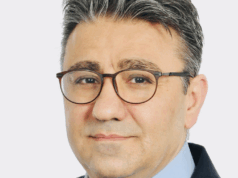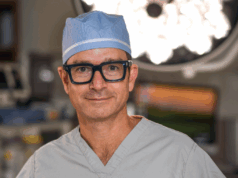
For the CX 2020 LIVE Aortic Podium 1st Session, 489 participants from 62 countries tuned in to hear a series of experts examine technological and procedural developments in the field. Among topics covered was the early, yet promising, clinical experience with fibre optic imaging technology in complex aortic interventions—identified as the future by 84% of the audience. The benefit of multidisciplinary teams in aortic treatment, the role of aortic wrapping for type A dissection patients, and the importance of a tailored approach to fragile aortas also emerged in the discussion. The session was chaired by Gustavo Oderich (Rochester, USA) and moderated by Roberto Chiesa (Milan, Italy).
Tilo Kölbel (Hamburg, Germany) opened with a presentation on the early clinical experience with Fibre Optic RealShape (FORS) technology (Philips) in complex aortic repair.
Although aortic interventions have developed “rapidly” from simple tubular stent grafts to fenestrated and branched devices using computed tomography (CT) for guidance, said Kölbel, “the hazard from radiation persists,” both for operators and for patients. He told the CX 2020 LIVE audience that FORS technology was developed using a laser fibre in catheters and wires to give a full 3D visualisation of materials without using radiation.
Kölbel detailed that the Hamburg team have used FORS in around 20 patients so far, and while the technology is still in its infancy, it represents a “revolutionary new tool on the horizon, which allows reliable 3D navigation […], has a high potential for reduction of radiation, improves workflow, and gives the operator more information about device position”.
Chiesa opened the discussion following Kölbel’s presentation, asking whether fibre optic technology could be a useful tool in dissection. Kölbel responded that the technology has not yet been applied in a very complex dissection case but noted that it could be a “very attractive” application.
Responding to a question from Egypt, Kölbel affirmed this technique can be used in peripheral arterial angioplasty and predicted a move into other areas, such as interventional neurology and cardiology.
Kölbel also stressed that currently this technology only reduces radiation from fluoroscopy. “We still do digital subtraction angiography [DSA] runs and at the end of the procedure we would do a normal final angiograph using contrast and normal radiation, so we cannot reduce that yet”. However, he highlighted: “The big advantage is that we may be able to do the procedure even faster than before and our patients will benefit from that”.
Finally, Oderich asked how soon FORS could be miniaturised to stents and a wider range of wires and catheters. “This is a very early release of the technology,” Kölbel emphasised. “Although it is CE marked, we only have the choice of two catheters and one wire, so it is not able to visualise implants and endovascular aneurysm repair (EVAR) devices, for instance.” He revealed that any updates were some time away.
Polling at the end of Kölbel’s talk revealed that 84% of the audience believe fibre optic technology is the way forward in complex aortic repair, which Oderich remarked was an “outstanding” result.
“That is a call for new technology and for further investment into development of smarter imaging,” Kölbel concluded. “When it comes to imaging, there have been a lot of improvements, but basically, we are working with Stone Age technology. I am really optimistic that we will see some modern ways of visualising materials inside the body very soon”.

Aortic wrapping technique highlights benefit of multidisciplinary approach
The value of multidisciplinary working across vascular and cardiothoracic specialties was underscored by Stéphan Haulon (Paris, France), who detailed his experience of off-pump wrapping of the ascending aorta as a treatment option for acute type A dissections. The procedure is offered to patients over the age of 70, Haulon said, for whom in-hospital mortality is “significantly” higher. The technique involves separating the ascending aorta from the pulmonary artery trunk and the right pulmonary artery, with a tailored Teflon plaque then placed around the aorta from the coronary ostia up to the innominate artery.
Haulon admitted that he was initially sceptical of the technique, but was subsequently impressed when he investigated the outcomes. “When I moved to Paris, I really questioned the outcomes of this technique and I asked my new cardiothoracic surgeon colleagues if I could look at the 30–day mortality [and] survival rate during follow-up secondary endpoints. They were very happy to show the database up to a 10-year period,” he said.
Haulon presented data from 35 patients treated with aortic wrapping, with a mean age of 77 years, of whom seven had major complications and 11 required reinterventions. Three patients died in-hospital within 30 days. Upon follow-up, which was at around 36 months on average, three patients required reintervention for aneurysm evolution and one patient died from dissection-related complication. The estimated survival rate at 12 months was 85%, Haulon told the CX 2020 LIVE audience, and 82% at 24 and 36 months.
Considering these results, Haulon commented that off-pump aortic wrapping is associated with favourable early outcomes and a low rate of aortic events during follow–up; he said that the technique should be considered for patients at high risk for conventional surgical repair. “It could be considered [as] a first step before ascending or arch endografting,” he concluded.

Haulon’s presentation sparked a flurry of interest from the CX 2020 LIVE global audience, with questions coming from as far afield as Brazil and Turkey, as well as from the presenting panel, with moderator Chiesa describing aortic wrapping as a “brave” approach. Topics included the indications for aortic wrapping, prevention of the proximal extension of the dissection, and proximal wrapping of the root.
On indications for aortic wrapping, Haulon commented that there was a “huge selection bias in the series,” as a lot of patients are not suitable for such a repair. He said: “We have treated a couple of chronic type A dissections, but we have also learned from that experience on acute type A [dissections], that we can create a sealing zone for any arch repair. Now when we do a hybrid repair of the arch, or when we want to perform an arch branch repair and we have no proximal sealing zone, we are now very happy to use this technique because we are confident about the long– term outcomes.”
Oderich then quizzed Haulon as to whether the technique could be used for enlargement of the ascending aorta to prepare a landing zone for a large device. Referring again to the joint vascular-cardiothoracic approach, Haulon responded: “What I have learned from the cardiothoracic surgeons here is that you can generate a stable ascending aorta landing zone by doing this quite aggressive wrapping. A very important technical point is that it is a Teflon plaque and not a graft that you suture around. This stays really nicely in position”.
New strategy for fragile aortas
Fabio Verzini (Turin, Italy) looked at a novel approach for the treatment of fragile aortas using the Valiant Navion thoracic stent graft (Medtronic).
“Aortic fragility, especially in acute dissection and intramural haematoma, puts patients at a higher risk for adverse aortic events. Other patients may have increased inflammatory states or elevated aortic wall stress, or challenging anatomies that further impact the thoracic endovascular aortic repair (TEVAR) procedure. There is a clear need to have endovascular devices with specific features to treat fragile aortas.”
Verzini added: “The Medtronic Navion device with Covered Seal proximal configuration allows for decreased vessel trauma thanks to its fully covered proximal edge. Moreover, the proximal edge of the covered seal flares and perfectly accommodates the inner curvature of the thoracic aorta. The accurate deployment system reduces manipulation and movements, and the enhanced graft design provides increased flexibility and conformability.”
In response to a question from Oderich about whether fragile aorta consisted of acute aortic syndrome alone or whether it should include connective tissue disorders, Verzini indicated that, based on his own experience, the definition could be broadened to encompass patients “with a thrombosed neck, as well as those who may have a genetically triggered disease and some female patients, especially if they present with arthritis or an inflammatory disease. These are the patients more at risk of developing complications, and I tend to think of them as fragile aorta more and more”.

SURPASS shows promising 30-day results
CX 2020 LIVE attendees heard from Giovanni Torsello (Münster, Germany) on the first results from the European SURPASS registry.
SURPASS investigated the performance of the TAG Conformable thoracic stent graft with Active Control System (Gore) in complex aortic pathologies. It is a prospective, non–randomised, single–arm, postmarket registry, with 125 patients in 20 European centres in seven countries. At 30 days, rates of technical and clinical success were 97.6%.
Torsello said: “The results were really excellent, treating patients not only with good anatomies, but also those with challenging pathologies of the thoracic aorta. This new delivery system made possible a controlled delivery of the stent graft, and also allowed correction of the positioning of the graft once it is implanted in the thoracic aorta.”
Update on Zenith Alpha results
Eric Verhoeven (Nuremberg, Germany) gave an insight into best practice using the Zenith Alpha low–profile abdominal aortic aneurysm (AAA) stent graft (Cook Medical). Verhoeven detailed the use of the device in 139 patients.
The survival rate at one year was reported as 96.5%, and 88.2% at three years. He noted that the freedom from reintervention rate stood at 86.8% at one year and 70.1% at two years. Verhoeven commented: “It [the Zenith Alpha] comes with a low profile, is very easy to deploy, flexible and conformable to the anatomy and, overall, our results are excellent.”
Industry Symposium addresses potential benefits of IVL
The Industry Symposium, sponsored by Shockwave Medical, addressed the potential benefits of intravascular lithotripsy (IVL), including its ability to reduce calcification prior to EVAR.
Frank Arko (Charlotte, USA) gave a presentation on the use of IVL before EVAR and aortoiliac occlusive disease, after having given a presentation during the CME part of the session on how endovascular sutured aneurysm repair (ESAR) can be an effective treatment in patients with a challenging sealing zone.
Arko was joined by Arne Schwindt (Münster, Germany) and Andrew Holden (Auckland, New Zealand) who spoke about IVL for calcified EVAR access and IVL in calcified aortoiliac occlusive disease, respectively.















